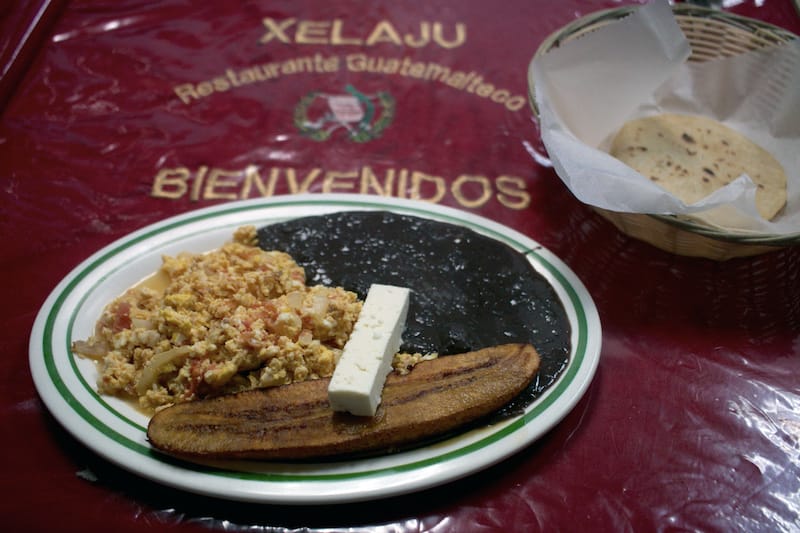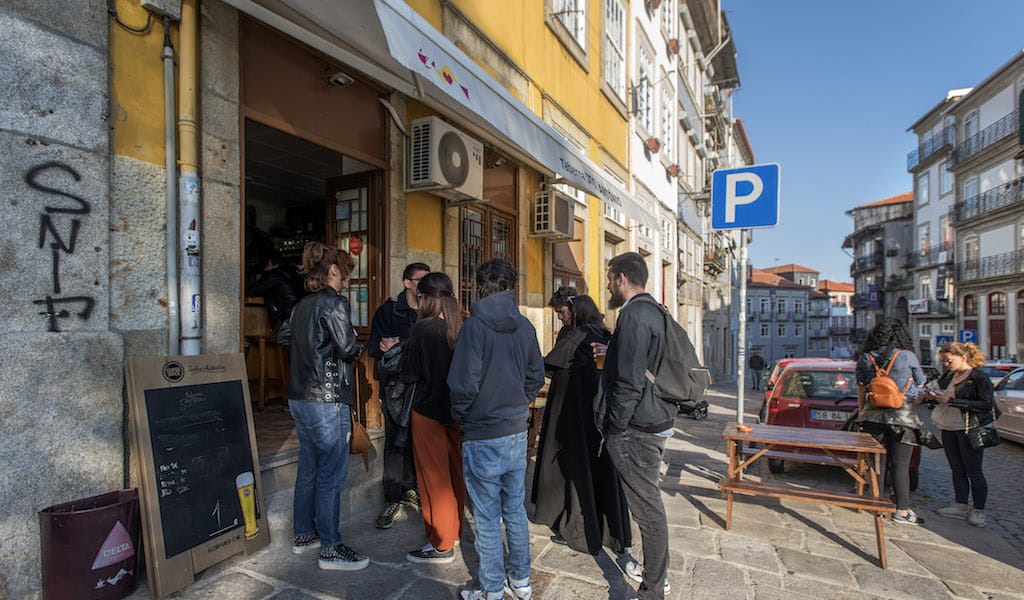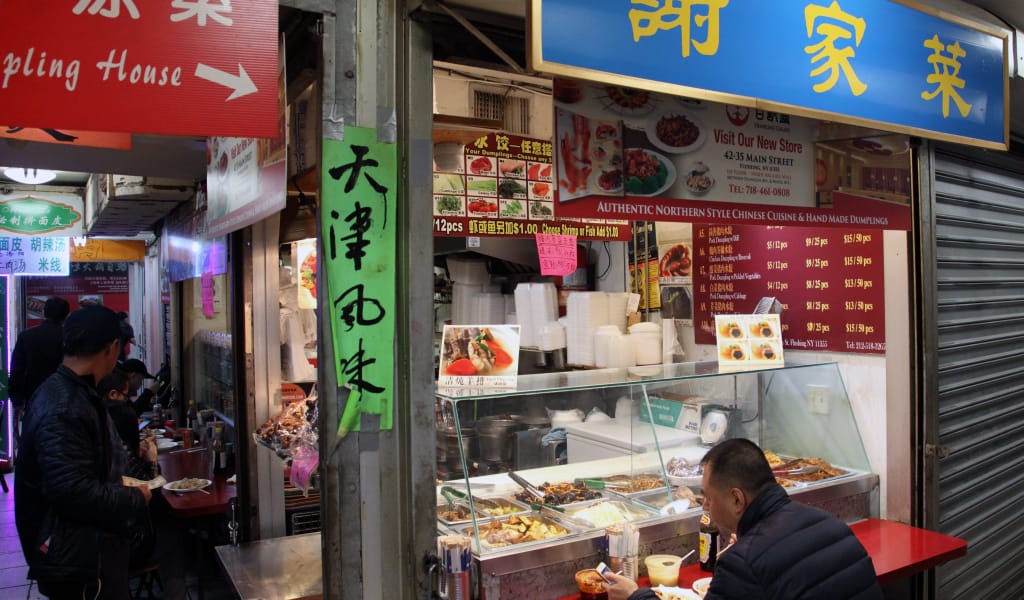Along Parsons Boulevard one cold night in January, a crowd of people in heavy winter coats line up for the buses that will take them to Rosedale, Hollis, and Pomonok. But behind a small storefront just steps away, Luna de Xelajú offers a transporting experience of a different kind, to somewhere much warmer.
The restaurant’s front room resembles the classic New York City pizzeria counter, with pies sitting in a glass display case to be heated by the slice. They do a brisk business, and their slices are popular with a diverse crowd, but the pizzas are an afterthought for most of the place’s clientele, who come to Luna de Xelajú’s front counter for the Central American-style pan. Guatemalan customers, most of whom hail from the country’s mountainous west, come to pick up champurradas or quesadillas, both sweet buttery pastries, to eat on their lunch breaks at nearby government and hospital buildings, or else to bring home and enjoy with family over coffee the next morning.

But there’s more here. Venture past the front pizza and bakery area and you will find a homey dining room with murals of a highland Guatemalan town, paintings of striking green-and-red quetzals, the national bird of Guatemala, and a taxidermy deer head, all hung on walls painted the baby blue of Guatemala’s flag. A flat screen in the corner of what is Luna de Xelajú’s back-room restaurant broadcasts soccer matches or Cartoon Network, and around the holidays, bright red poinsettias add another splash of color to this brilliant little nook. Alongside paintings of Quetzaltenango, though, idyllic images of Venice and Tuscany still adorn the walls, leftover from when the restaurant was a simple pizzeria with Italian-American owners.
Even the food looks vibrant: pepian, a chicken stew made with finely ground pumpkin and sesame seeds, is almost glowingly orange. Pacaya forrada consists of the tentacle-like fronds of the tepejilote flower battered with eggs and fried, before being doused with a rich red salsa. Half of a lime brightens up the platter of salpicon, which here is a surprisingly delicate salad made with shredded beef and finely minced onions, radishes and cilantro.
Most main courses come with a mound of rice and a pool of savory refried black beans that taste like Central American soul food. Guatemalan-style thick tortillas accompany all orders including the popular breakfasts, which are usually some combination of eggs, beans, plantains, chorizo and queso fresco or crema, the thin, tangy sour cream product of Central America.
“When they come here,” Boris says, “they don’t forget their roots.”
Luna de Xelajú, whose name refers to the moon over the city of Quetzaltenango (also known by its Mayan name, Xelajú), is a family operation. Luis Mejía, the owner, is in and out of the restaurant most days while his wife, Sulma, manages the place and his son Boris bakes bread and pastries. Luis’s daughter and her cousin work as servers in the back dining room, although the pizza and bakery counter at the front are staffed by non-relations. But, as Boris told us, everybody at Xelajú does a little bit of everything. He will sometimes have to go out and make deliveries, and Sulma frequently works behind the scenes in the kitchen.
The Mejías trace their origins to Chiquimulilla, a town in the eastern department of Santa Rosa, not far from the border with El Salvador and the Pacific Ocean. Boris came to the U.S. at the age of 15, and then attended high school and a year of college in Queens before deciding to devote all of his time to working at the restaurant, which his father opened in 2003 after buying the pizzeria from its Italian-American owners.
On a fairly slow Saturday morning, Boris was preparing tray after tray of panes dulces like gusanos, worm-shaped croissant rolls, and molletes, sweet buns topped with little “volcanos” of butter and sugar. In the early days of his father’s business, when it was just a sit-down restaurant and pizzeria, Boris was the one who originally suggested adding a panadería to bring in more customers. Apparently it’s paid off – while the pizzeria brings in a loyal and diverse customer base, Boris says 75 percent of his clientele are Guatemalan, and the majority come only to buy the specialty bread. “The rent is getting higher and higher,” he explains, “so the more people you can serve the better.” As we talked, Boris continued to churn out a tray of pan dulce about every five minutes.

At Luna de Xelajú it’s precisely the high turnover of the panadería and pizzeria that allows for the complex and time-consuming traditional dishes served in the back room. Of these, Boris’s personal favorite is the hilachas, a slow-cooked beef stew whose name refers to rags for the same reason that the Cuban dish ropa vieja is named after old clothes. The beef, cooked for hours with tomatoes, tomatillos and various chiles, falls apart into tender threads.
These distinctive home-style dishes, as much as the pan dulce, keep loyal Guatemalan customers coming back. While weekdays see primarily workers from nearby buildings stopping by the bakery, on weekends the dining room fills up with families filling up on the food that reminds them of home. One server told us she frequently talks to Guatemalans who’ve driven from far out on Long Island, New Jersey and even Maryland, because they’ve heard that Luna de Xelajú offers dishes that are hard to find in the U.S. Even within New York, Guatemalan restaurants and bakeries are few and far between, and Luna de Xelajú has by far the widest selection of specialties.
At one table in the back, a woman named Ingrid was eating carne asada with her mother and husband. They had traveled to the city from Syracuse to do some business at the Guatemalan consulate in Manhattan, and Ingrid made sure they had enough time to visit Luna de Xelajú, since Syracuse has no Central American restaurants to speak of. The meal was a welcome taste of home, and as the family left they made sure to pick up some pan dulce for later.
“When they come here,” Boris tells us, “they don’t forget their roots.”
 June 21, 2021 Taberna Santo António
June 21, 2021 Taberna Santo António
We arrived at Taberna Santo António after lunch, looking for a bit of warmth in the […] Posted in Porto August 21, 2019 Beyond the Courts
August 21, 2019 Beyond the Courts
Each year in late summer, some of the best athletes on the planet converge on Flushing […] Posted in Queens July 24, 2019 Totò Eduardo E Pasta E Fagioli
July 24, 2019 Totò Eduardo E Pasta E Fagioli
The Neapolitan stairs are ancient urban routes that connect the upper city (the Vomero […] Posted in Naples
Ike AllenIke Allen
Published on February 01, 2019
Related stories
June 21, 2021
Porto | By Cláudia Brandão
PortoWe arrived at Taberna Santo António after lunch, looking for a bit of warmth in the middle of winter. It wasn’t a shot in the dark – we already knew that we would be enveloped by a comforting hospitality at this classic Porto spot. The sun was shining, so we sat on the terrace with…
Discover all that Queens has to offer on our culinary walk!
August 21, 2019
QueensEach year in late summer, some of the best athletes on the planet converge on Flushing Meadows Corona Park to compete in the United States Open Tennis Championships. In 2019, the U.S. Open begins with practice sessions and qualifier matches on Monday, August 19, and concludes with the men’s singles final, scheduled for Sunday, September…
July 24, 2019
NaplesThe Neapolitan stairs are ancient urban routes that connect the upper city (the Vomero district) to the lower city (the historic center). The most famous of these stairs is the Pedamentina di San Martino, a staircase of 414 steps dating back to the 14th century, which starts from the old center and reaches the Castel…



















































































